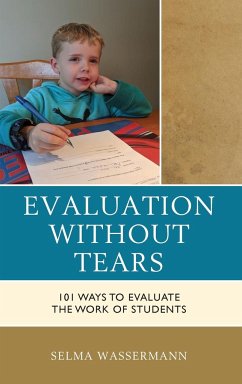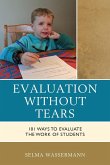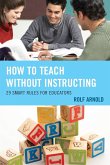- Gebundenes Buch
- Merkliste
- Auf die Merkliste
- Bewerten Bewerten
- Teilen
- Produkt teilen
- Produkterinnerung
- Produkterinnerung
This tackles the fallacies of marking and grading students' work and provides teachers with specific examples of how they might provide evaluative feedback to students that enables and promotes their subsequent growth on learning tasks.
Andere Kunden interessierten sich auch für
![Evaluation without Tears Evaluation without Tears]() Selma WassermannEvaluation without Tears36,99 €
Selma WassermannEvaluation without Tears36,99 €![Discipline Without Tears Discipline Without Tears]() Rudolf DreikursDiscipline Without Tears18,99 €
Rudolf DreikursDiscipline Without Tears18,99 €![How to Teach without Instructing How to Teach without Instructing]() Rolf ArnoldHow to Teach without Instructing50,99 €
Rolf ArnoldHow to Teach without Instructing50,99 €![How to Teach without Instructing How to Teach without Instructing]() Rolf ArnoldHow to Teach without Instructing93,99 €
Rolf ArnoldHow to Teach without Instructing93,99 €![Text-book Of Light-line Shorthand: A Practical, Phonetic System, Without Shading Text-book Of Light-line Shorthand: A Practical, Phonetic System, Without Shading]() Roscoe Lorenzo EamesText-book Of Light-line Shorthand: A Practical, Phonetic System, Without Shading31,99 €
Roscoe Lorenzo EamesText-book Of Light-line Shorthand: A Practical, Phonetic System, Without Shading31,99 €![Growing Without Schooling Growing Without Schooling]() John C HoltGrowing Without Schooling29,99 €
John C HoltGrowing Without Schooling29,99 €![Arithmology, Or, Theory of Common Arithmetic: Fully Proved Without Algebra Arithmology, Or, Theory of Common Arithmetic: Fully Proved Without Algebra]() Solomon Edward CaspersonnArithmology, Or, Theory of Common Arithmetic: Fully Proved Without Algebra27,99 €
Solomon Edward CaspersonnArithmology, Or, Theory of Common Arithmetic: Fully Proved Without Algebra27,99 €-
-
-
This tackles the fallacies of marking and grading students' work and provides teachers with specific examples of how they might provide evaluative feedback to students that enables and promotes their subsequent growth on learning tasks.
Produktdetails
- Produktdetails
- Verlag: Rowman & Littlefield Publishers
- Seitenzahl: 152
- Erscheinungstermin: 15. Januar 2020
- Englisch
- Abmessung: 235mm x 157mm x 13mm
- Gewicht: 381g
- ISBN-13: 9781475853490
- ISBN-10: 1475853491
- Artikelnr.: 58019278
- Herstellerkennzeichnung
- Libri GmbH
- Europaallee 1
- 36244 Bad Hersfeld
- gpsr@libri.de
- Verlag: Rowman & Littlefield Publishers
- Seitenzahl: 152
- Erscheinungstermin: 15. Januar 2020
- Englisch
- Abmessung: 235mm x 157mm x 13mm
- Gewicht: 381g
- ISBN-13: 9781475853490
- ISBN-10: 1475853491
- Artikelnr.: 58019278
- Herstellerkennzeichnung
- Libri GmbH
- Europaallee 1
- 36244 Bad Hersfeld
- gpsr@libri.de
Selma Wassermann is Professor Emerita in the Faculty of Education at Simon Fraser University. Her books include What's the Right Thing to Do? (2019), The Art of Interactive Teaching (2017), This Teaching Life (2004), Teaching for Thinking Today (2009) and An Introduction to Case Method Teaching: A Guide to the Galaxy (1994).
Introduction
Preface
Acknowledgements
Chapter 1: What's Evaluation For?
Force of Habit
What's Evaluation For?
Chapter 2: Marking and Grading: The Tail that Wags the Dog
A House of Cards
Chapter 3: A Case for Using Evaluative Feedback
Evaluation as Feedback
Obstacles to Using Evaluative Feedback In Lieu of Grades
Chapter 4: Evaluative Feedback that Enables and Promotes Growth
Identifying the Criteria: What are we looking for?
What is Being Measured?
Learning Goals and Evaluation Practices
Chapter 5: Written Diagnostic Evaluative Feedback Across the Curriculum
Examples from the Primary Grades
Examples from the Intermediate Grades
Examples from Secondary School
Conclusion
Chapter 6: It's All About How You Say It
Reflecting in Action
Examining a Classroom Discussion
Hooked on Praise
Chapter 7: Impediments to Good Diagnostic Judgment
Taming the Impulse to Punish by Evaluative Judgment
Two Cents Worth of Advice to Teachers
Chapter 8: Reporting to Parents
Some examples of teachers' written reports
Parent-teacher-student conferences
Chapter 9: Students as Self Evaluators
Children Evaluating Themselves in the Primary Grades - The Child in the
Process
Written Self-Evaluation Reports in the Primary Grades
Students Evaluating Themselves in a One-on-One Tutorial
Students Evaluating Themselves in the Secondary School
Teachers' Assessments on the Profiles
Conclusion
Chapter 10: Institutional Changes Toward Using Evaluative Feedback in
Reporting to Parents
Examples of Schools that "Dare to Be Different"
Chapter 11: Evaluation as a Subversive Activity: What Can a Teacher Do?
Chapter 12: Postscript: A Personal Odyssey
A Professional Journey
References
Index
About the Author
Preface
Acknowledgements
Chapter 1: What's Evaluation For?
Force of Habit
What's Evaluation For?
Chapter 2: Marking and Grading: The Tail that Wags the Dog
A House of Cards
Chapter 3: A Case for Using Evaluative Feedback
Evaluation as Feedback
Obstacles to Using Evaluative Feedback In Lieu of Grades
Chapter 4: Evaluative Feedback that Enables and Promotes Growth
Identifying the Criteria: What are we looking for?
What is Being Measured?
Learning Goals and Evaluation Practices
Chapter 5: Written Diagnostic Evaluative Feedback Across the Curriculum
Examples from the Primary Grades
Examples from the Intermediate Grades
Examples from Secondary School
Conclusion
Chapter 6: It's All About How You Say It
Reflecting in Action
Examining a Classroom Discussion
Hooked on Praise
Chapter 7: Impediments to Good Diagnostic Judgment
Taming the Impulse to Punish by Evaluative Judgment
Two Cents Worth of Advice to Teachers
Chapter 8: Reporting to Parents
Some examples of teachers' written reports
Parent-teacher-student conferences
Chapter 9: Students as Self Evaluators
Children Evaluating Themselves in the Primary Grades - The Child in the
Process
Written Self-Evaluation Reports in the Primary Grades
Students Evaluating Themselves in a One-on-One Tutorial
Students Evaluating Themselves in the Secondary School
Teachers' Assessments on the Profiles
Conclusion
Chapter 10: Institutional Changes Toward Using Evaluative Feedback in
Reporting to Parents
Examples of Schools that "Dare to Be Different"
Chapter 11: Evaluation as a Subversive Activity: What Can a Teacher Do?
Chapter 12: Postscript: A Personal Odyssey
A Professional Journey
References
Index
About the Author
Introduction
Preface
Acknowledgements
Chapter 1: What's Evaluation For?
Force of Habit
What's Evaluation For?
Chapter 2: Marking and Grading: The Tail that Wags the Dog
A House of Cards
Chapter 3: A Case for Using Evaluative Feedback
Evaluation as Feedback
Obstacles to Using Evaluative Feedback In Lieu of Grades
Chapter 4: Evaluative Feedback that Enables and Promotes Growth
Identifying the Criteria: What are we looking for?
What is Being Measured?
Learning Goals and Evaluation Practices
Chapter 5: Written Diagnostic Evaluative Feedback Across the Curriculum
Examples from the Primary Grades
Examples from the Intermediate Grades
Examples from Secondary School
Conclusion
Chapter 6: It's All About How You Say It
Reflecting in Action
Examining a Classroom Discussion
Hooked on Praise
Chapter 7: Impediments to Good Diagnostic Judgment
Taming the Impulse to Punish by Evaluative Judgment
Two Cents Worth of Advice to Teachers
Chapter 8: Reporting to Parents
Some examples of teachers' written reports
Parent-teacher-student conferences
Chapter 9: Students as Self Evaluators
Children Evaluating Themselves in the Primary Grades - The Child in the
Process
Written Self-Evaluation Reports in the Primary Grades
Students Evaluating Themselves in a One-on-One Tutorial
Students Evaluating Themselves in the Secondary School
Teachers' Assessments on the Profiles
Conclusion
Chapter 10: Institutional Changes Toward Using Evaluative Feedback in
Reporting to Parents
Examples of Schools that "Dare to Be Different"
Chapter 11: Evaluation as a Subversive Activity: What Can a Teacher Do?
Chapter 12: Postscript: A Personal Odyssey
A Professional Journey
References
Index
About the Author
Preface
Acknowledgements
Chapter 1: What's Evaluation For?
Force of Habit
What's Evaluation For?
Chapter 2: Marking and Grading: The Tail that Wags the Dog
A House of Cards
Chapter 3: A Case for Using Evaluative Feedback
Evaluation as Feedback
Obstacles to Using Evaluative Feedback In Lieu of Grades
Chapter 4: Evaluative Feedback that Enables and Promotes Growth
Identifying the Criteria: What are we looking for?
What is Being Measured?
Learning Goals and Evaluation Practices
Chapter 5: Written Diagnostic Evaluative Feedback Across the Curriculum
Examples from the Primary Grades
Examples from the Intermediate Grades
Examples from Secondary School
Conclusion
Chapter 6: It's All About How You Say It
Reflecting in Action
Examining a Classroom Discussion
Hooked on Praise
Chapter 7: Impediments to Good Diagnostic Judgment
Taming the Impulse to Punish by Evaluative Judgment
Two Cents Worth of Advice to Teachers
Chapter 8: Reporting to Parents
Some examples of teachers' written reports
Parent-teacher-student conferences
Chapter 9: Students as Self Evaluators
Children Evaluating Themselves in the Primary Grades - The Child in the
Process
Written Self-Evaluation Reports in the Primary Grades
Students Evaluating Themselves in a One-on-One Tutorial
Students Evaluating Themselves in the Secondary School
Teachers' Assessments on the Profiles
Conclusion
Chapter 10: Institutional Changes Toward Using Evaluative Feedback in
Reporting to Parents
Examples of Schools that "Dare to Be Different"
Chapter 11: Evaluation as a Subversive Activity: What Can a Teacher Do?
Chapter 12: Postscript: A Personal Odyssey
A Professional Journey
References
Index
About the Author








